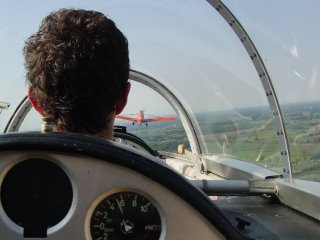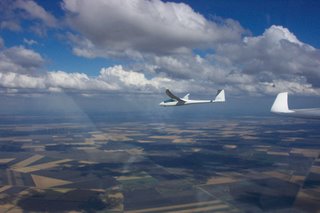Soaring in a glider, you hear only the wind and feel the whoosh of thermal current carrying you upward.
BY RICHARD CHIN
Pioneer Press in Minnesota
Like a circle in a spiral, like a wheel within a wheel, never ending or beginning, on an ever-spinning reel …
We don't know about you, but mention sailplanes and we immediately think of the scene from the original "The Thomas Crown Affair," where Steve McQueen soars through the sky in his glider while the soundtrack warbles the Oscar-winning "Windmills of Your Mind."
There weren't any late-1960s pop hits playing when we took a glider ride in Faribault recently, but we can report that the experience was still Steve McQueen cool. In case you haven't seen "The Thomas Crown Affair," soaring is a sport in which you fly a sleek, motorless glider that's towed a few thousand feet up into the air by a powered airplane. Once aloft, your glider — also called a sailplane — disconnects from the tow rope, and if you're a good pilot and conditions are favorable, you can soar for hours and hundreds of miles, riding the updrafts like a giant, carbon-fiber eagle.
Local soaring clubs are based out of airports in Stanton, Minn., and Osceola, Wis. Cross Country Soaring, at the Faribault Airport, is a commercial soaring operation. Cross Country Soaring owner Don Ingraham is a veteran soaring pilot, competitor and instructor. The 52-year-old is a former supercomputer instructor with Cray Research who turned his avocation into his living two seasons ago, offering rides, rentals, instructions and tows. Before our flight, Ingraham familiarized me with the cockpit of the Grobe 103, one of two German high-performance two-seat trainers he owns.
The student or passenger sits in the front seat, in front of a duplicate of the instrument panels and controls Ingraham handles in the back seat. "This is the canopy eject," Ingraham said, pointing to a knob at my elbow as I settled into the cockpit. "Since we don't have parachutes, you won't have any reason to use that." We strapped on our seatbelts, closed up the Plexiglas canopy, and Ingraham went through his flight checks.
The tow plane took up the slack in the 200-foot towrope, and we started to move down the runway. It felt sort of like being in an enclosed go-kart at first. The seats in a sailplane are in a semi-reclined position, and you roll low to the ground, since the landing wheel only just protrudes out of the plane's belly.
 But in a few seconds, we were moving at 50 mph and up in the air, ascending behind the tow plane. A few minutes of climbing and we were a mile closer to the fluffy, cotton-white clouds hanging over Faribault. "It's a gorgeous day," Ingraham said. The air was cool and dry. The sun was hitting the ground. Good conditions to create the updrafts soaring pilots seek.
But in a few seconds, we were moving at 50 mph and up in the air, ascending behind the tow plane. A few minutes of climbing and we were a mile closer to the fluffy, cotton-white clouds hanging over Faribault. "It's a gorgeous day," Ingraham said. The air was cool and dry. The sun was hitting the ground. Good conditions to create the updrafts soaring pilots seek.Ingraham told me to tug on a yellow knob next to my knee. The yellow rope dropped away, and the tow plane banked to the left as we turned to the right.
"It's magic," Ingraham said on the ground, trying to describe the appeal of soaring. "It's the natural feel of flying," said Louis Stanley, a Lakeville resident who took a birthday-gift ride with his son and grandson the same weekend. "You feel like a bird up there."
"It's a good way to be close to God," said tow-plane pilot Jose Hernandez.
As I watched the tow plane spiral below us back to the airport, I understood what they meant.
Without an engine, there's no constant roar and vibration. In a sailplane, you hear only the sound of the wind speeding over the canopy and fuselage and feel the whoosh of thermal current carrying you upward.
As I watched the tow plane spiral below us back to the airport, I understood what they meant.
Without an engine, there's no constant roar and vibration. In a sailplane, you hear only the sound of the wind speeding over the canopy and fuselage and feel the whoosh of thermal current carrying you upward.

Even if it was only the lakes and flat, brown farm fields of Faribault beneath us, the view through the big Plexiglas canopy was terrific. We cruised in gentle circles above the airport, moving at about highway speeds and chatting in normal voices, as Ingraham searched for the currents that could keep us up all afternoon or carry us down to Iowa if we wanted.
Ingraham maneuvered under a thick cloud, and we started a circling climb to it.
Clouds are condensed water, an indication that rising moist air might be below, waiting to give us a lift. Ingraham told me to turn a knob on the instrument panel — the volume control for the audio variometer — and we started to hear a whining tone.
A vario is a gauge that tells you your rate of ascent or descent. The audio vario operates like a Geiger counter. The pitch in tone gets higher as your rate of climb increases, and it drops in pitch as you descend. You can get the same information from a visual vario dial on the instrument panel, but the audio vario lets Ingraham keep his eyes on the sky while his ears look for a lift, steering toward the high-pitched tone.
A vario is a gauge that tells you your rate of ascent or descent. The audio vario operates like a Geiger counter. The pitch in tone gets higher as your rate of climb increases, and it drops in pitch as you descend. You can get the same information from a visual vario dial on the instrument panel, but the audio vario lets Ingraham keep his eyes on the sky while his ears look for a lift, steering toward the high-pitched tone.

Sailplane pilots also keep an eye out for circling birds who are looking for a free ride skyward or are just lunching on bugs that are caught in a thermal updraft.
Ingraham pointed out some company. "We've got two hawks to fly with. We're going to join them. They're the experts," he said. I gaped at the two redtails soaring just above our canopy, seemingly undisturbed by our presence. Another clue on how to find a good thermal is to watch other sailplanes. We spotted a single-seat model and started circling each other. It was a beautiful sight.
Long and slender, sailplanes look like supermodel swans. They're usually always painted white, because the composite materials used to build them will weaken if they get too hot.
They aren't cheap. Lower-performing models can be had for about $8,000, Ingraham said. But you can pay tens of thousands for competition models. A new version of his trainer, with instruments and trailer, would cost about $120,000, Ingraham said.
"I find this a lot more thrilling," said Shannon Geer, a 35-year-old private pilot who is taking sailplane lessons from Ingraham. "No engines. Landing, you get one shot at it."
Lots of sailplane pilots come from sailing backgrounds, Ingraham added. That isn't surprising. There are lots of similarities. Both are kind of pricey, aesthetically pleasing and involve the intellectual challenge of harnessing ever-changing, invisible wind currents as opposed to just pushing an accelerator.
When Ingraham let me give it a try, I found that just the slightest pressure on the control stick changes the plane's direction. Ingraham said helicopter pilots often make good sailplane students because they have a subtle touch.

Ingraham can give passengers a smooth, gentle ride. But sailplanes are capable of roller-coaster swoops. Ingraham demonstrated a wingover, a banking climbing turn, with a brief feeling of weightlessness at the top and a gulp-inducing view of the ground below. Loops and spins are possible. too, but you need to be wearing parachutes, Ingraham said.
With the right pilot, plane and conditions, sailplanes are capable of climbing as fast at 3,000 feet per minute and reaching altitudes that require oxygen masks. On average, a couple of people are killed in sailplanes each year, Ingraham said. But he thinks soaring is probably safer than private power-plane flight. Eventually, Ingraham wound the plane down toward the airport, using the airbrakes on the wings to get us down to 45 mph and a gentle touchdown.
Without a motor, he has only one shot at a landing. But on cross-country trips, if he has to, he only needs a few hundred feet of farm field to land.
"There's a million places to land," he said, indicating the flat fields around us.
Most farmers like the novelty of a sailplane visitor, Ingraham said. And when he lands in a field, it's only about a 15-minute job to take off the wings and tail. Then all he has to do is wait for his wife to arrive with the trailer to pick him and the plane up for the drive home.

